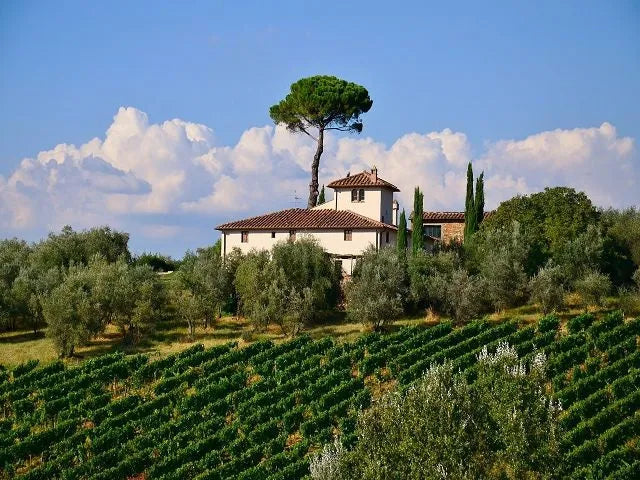
Garganega Wine
Garganega Wine
Italian white wine enthusiast, have you already succumbed to the charm of Garganega? This ancestral grape variety from Veneto, the undisputed star of Soave, offers wines of rare elegance combining lemony freshness, sweet almond notes, and captivating floral touches. From light aperitifs to great aging wines, Garganega seduces with its versatility and ability to faithfully express its volcanic terroir. An essential discovery for anyone wanting to explore the little-known jewels of wine-producing Italy!
Garganega Wine
Garganega: The Discreet Elegance of Veneto
In the rich landscape of Italian white grape varieties, Garganega occupies a special place. Less publicized than Pinot Grigio or Vermentino, this ancestral grape variety is nevertheless the soul of Veneto's great white wines, notably the famous Soave. Its aromatic finesse, balanced structure, and ability to faithfully translate its terroir make it a treasure of Italian wine heritage that deserves to be better known.
A Millennial History Rooted in Northeastern Italy
Garganega is one of Italy's oldest grape varieties, cultivated in Veneto since Roman times. Some documents attest to its presence in the Verona region as early as the 13th century, where it was already appreciated for the quality and consistency of its wines.
Its name could derive from "gargano," referring to its naturally generous productivity. Despite this abundance, the best producers have always known how to control yields to fully express the qualitative potential of this grape variety.
For a long time, Garganega remained confined to its historical cradle. Even today, it remains deeply linked to Veneto, where it represents nearly 80% of the grape composition of Soave, its most prestigious appellation.
A Subtle and Elegant Aromatic Profile
Garganega is distinguished by an aromatic profile of great finesse:
On the nose: delicate aromas of white flowers (acacia, chamomile), white-fleshed fruits (apple, pear), citrus, and the characteristic note of sweet almond
On the palate: a silky texture, with well-integrated acidity and a medium structure that brings balance and freshness
Finish: often marked by a pleasant mineral note, sometimes slightly saline in the great volcanic terroirs
This aromatic delicacy should not be confused with simplicity. Great Garganegas, particularly those from old vines and controlled yields, offer remarkable complexity and depth, with excellent aging potential. With time, these wines develop richer notes of dried fruits, honey, and aromatic herbs.
Garganega's Expression Terroirs
Garganega flourishes particularly in certain specific terroirs:
Soave Classico: The historical heart of the appellation, with its volcanic and limestone soils, produces wines of exceptional minerality and complexity. Crus like Calvarino, La Rocca, or Monte Grande are emblematic of this potential.
Gambellara: Located east of Soave, this lesser-known appellation also offers volcanic soils where Garganega expresses a pronounced minerality and beautiful vivacity.
Colli Berici: In this area, Garganega produces rounder and fruitier wines, often very accessible in their youth.
The Different Expressions of Garganega
The versatility of this grape variety is manifested through different wine styles:
Dry Soave: The classic expression, fresh and fruity, perfect for aperitifs or light dishes
Soave Classico: More structured and complex, from the historical heart of the appellation, with excellent aging potential
Recioto di Soave: Sweet wine made from dried grapes, offering rich notes of honey, dried apricot, and almond
Sparkling wines: More rare, but Garganega's natural freshness lends itself well to the production of elegant sparkling wines
How to Appreciate Garganega?
To fully enjoy this multifaceted grape variety:
Serving temperature: 8-10°C for simple cuvées, 10-12°C for grand crus and older wines
Decanting: Generally not necessary, except for old vintages that can benefit from slight oxygenation
Glassware: A medium-sized white wine glass, slightly flared to concentrate the aromas
Aging potential: 2-3 years for standard Soave, 5-10 years for grand crus, 15-20 years for Recioto
Gastronomic Pairings: Italian Finesse
Garganega's balanced structure and delicate aromas make it an ideal companion at the table:
Seafood: Seafood risotto, fritto misto di mare, oysters
Fish: Grilled sea bream with herbs, Venetian cod
Pasta and risottos: Asparagus risotto, pasta primavera, spaghetti alle vongole
Cheeses: Fresh Asiago, mozzarella di bufala, ricotta
For Recioto di Soave, opt for almond desserts, a fruit tart, or even foie gras for a more daring pairing.
The Qualitative Renaissance of Garganega
After a period where quantity sometimes prevailed over quality, Garganega has experienced a true renaissance in recent decades. Passionate producers like Pieropan, Inama, or Prà have demonstrated the exceptional potential of this grape variety when it is cultivated with care and vinified with respect.
This rediscovery is accompanied by a better definition of terroirs, more precise viticulture, and vinification adapted to each plot. The result is the emergence of terroir wines, capable of expressing with finesse the nuances of the region's different soils and microclimates.
A Grape Variety to Discover and Rediscover
Garganega perfectly embodies the richness and diversity of Italian wine heritage. In a market sometimes dominated by a few international grape varieties, it offers a refreshing alternative, with wines of natural elegance and remarkable authenticity.
Whether you are a fan of fresh and fruity whites for aperitifs or in search of complex aging wines, Garganega will seduce you with its versatility and finesse. Its ability to faithfully express its terroir, combined with an excellent price-quality ratio, makes it a grape variety that every wine lover should explore.
The next time you hesitate in front of a shelf of Italian wines, don't forget to look for a good Soave made from Garganega - you might make one of your most beautiful wine discoveries!
Return to our list of grape varieties.





